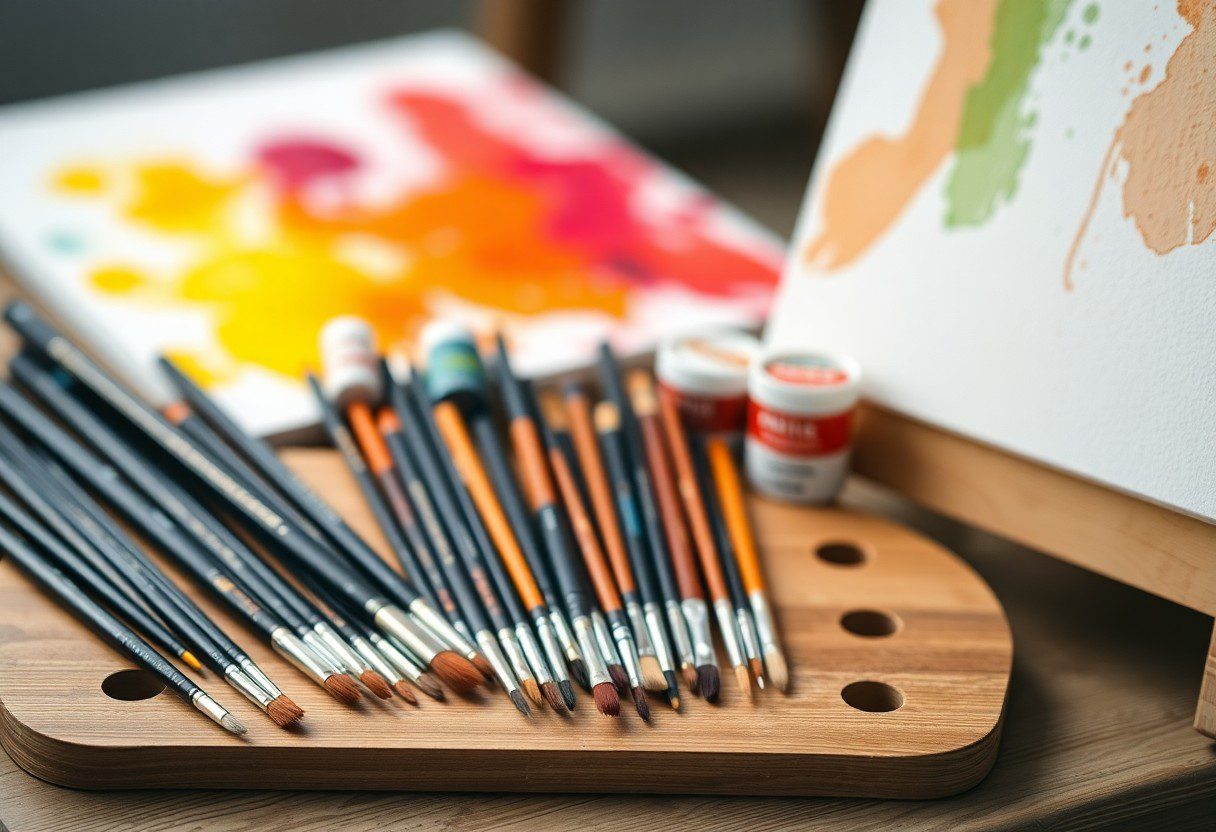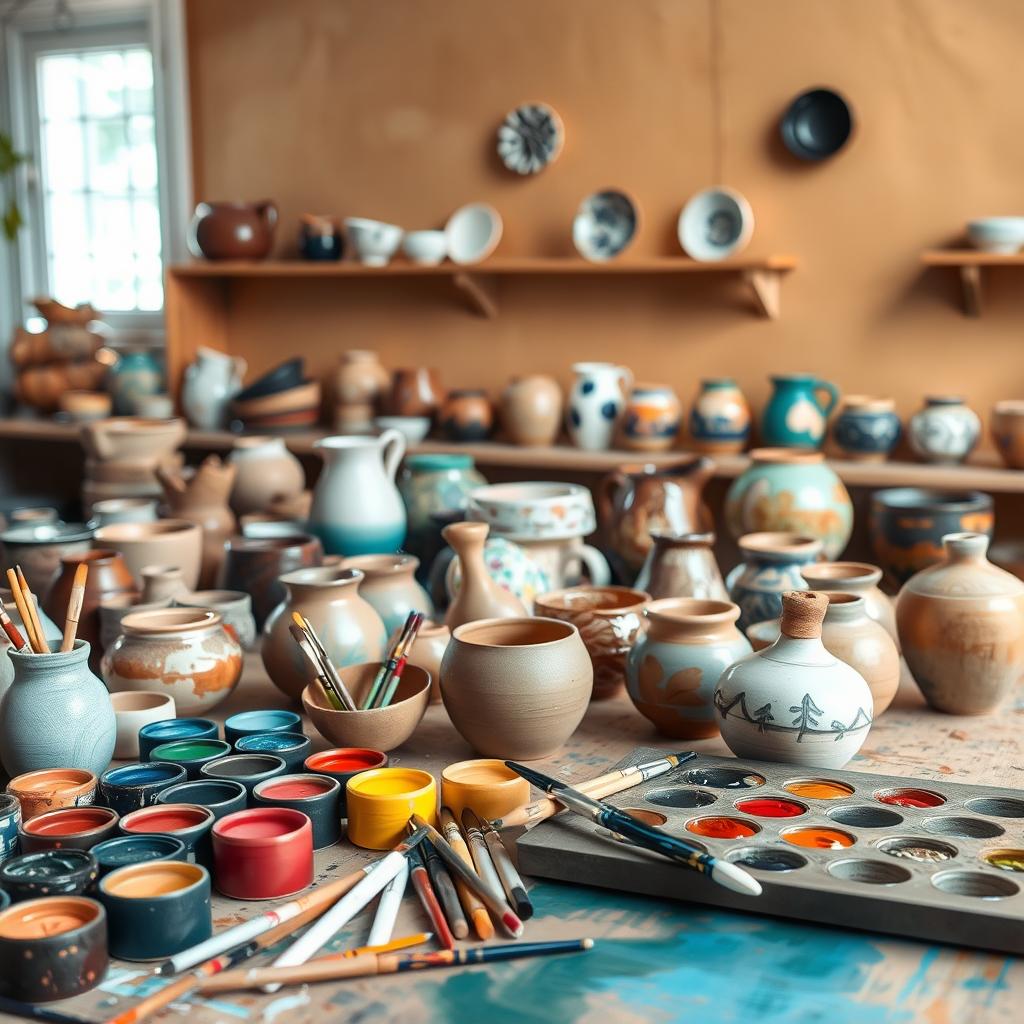Many aspiring and experienced artists often struggle with selecting the right tools for their craft. In the matter of acrylic painting, the type of brush you use can dramatically impact your technique, style, and overall outcome of your artwork. In this guide, we will explore various brush types and provide you with crucial tips to help you choose the best brushes that suit your needs and preferences. By the end, you’ll be equipped to make informed choices that elevate your acrylic painting experience.
Understanding Acrylic Paint
Acrylic paint is a versatile medium favored by artists for its rapid drying time and vibrant colors. It is made from pigments suspended in an acrylic polymer emulsion, allowing it to be thinned with water while still maintaining its integrity. With the ability to mimic both watercolor and oil paint techniques, acrylics are perfect for various painting styles and surfaces, making them a popular choice for artists of all skill levels.
Characteristics of Acrylic Paint
One of the defining features of acrylic paint is its quick drying time, which allows you to layer your work without lengthy waits. Additionally, acrylics are water-soluble when wet, making them easy to clean up and manipulate. Once dry, they become water-resistant and extremely durable, allowing your artwork to withstand the test of time.
Benefits of Using Acrylic Paint
With acrylic paint, you gain access to a wide range of colors and flexibility. This medium adheres well to a variety of surfaces, from canvas to wood, allowing for creative exploration. Furthermore, acrylics are less toxic compared to oil paints, providing you with a safer painting experience.
This means you can enjoy your art sessions without worrying about harmful fumes. Acrylic paint dries quickly, enabling you to finish projects efficiently, while its vibrant colors hold up remarkably well over time. The versatility of acrylics allows you to experiment with different techniques, from thin washes to thick impasto applications, giving your artwork depth and character. Ultimately, using acrylic paint enhances your creative freedom and ensures you can produce beautiful, lasting pieces.
Types of Brushes for Acrylic Painting
While selecting the right brushes is vital for achieving desired results in your acrylic paintings, understanding the different types of brushes is necessary. Here’s a quick overview:
| Brush Type | Characteristics |
| Flat Brushes | Wide, rectangular shape, ideal for bold strokes. |
| Round Brushes | Pointed tip, perfect for details and fine lines. |
| Filbert Brushes | Hybrid of flat and round, useful for soft edges. |
| Fan Brushes | Unique shape, great for textures and effects. |
| Detail Brushes | Small, fine bristles for intricate work. |
Thou should choose brush types based on the techniques you plan to use.
Flat Brushes
Across various styles, flat brushes are recognized for their wide, rectangular shape, making them ideal for creating broad strokes and filling larger areas of your canvas. They allow for achieving both thick and thin lines based on the angle you hold them. These brushes are especially handy when you want to cover ground quickly and efficiently.
Round Brushes
Brushes of this type are versatile and come with a pointed tip that is excellent for achieving fine lines and details. They are particularly useful for painting smaller components within your artwork or creating intricate patterns.
It’s necessary to use round brushes when you need precise control over your paint application. Their versatility makes them a favorite among many artists. You can create everything from delicate details in portraits to bold expressive strokes in landscapes. However, be cautious, as these brushes may wear out quicker if used with heavy gel mediums or extreme pressure.
Selecting the Right Brush Material
There’s a myriad of brush materials available, and choosing the right one can significantly enhance your acrylic painting experience. Each type of brush material offers unique benefits, impacting the way paint is applied and the texture of your artwork. By understanding the features of different materials, you can select a brush that aligns with your painting style and technique, allowing you to achieve the best results and bring your creative vision to life.
Synthetic vs. Natural Hair Brushes
Before you make a decision, it’s important to weigh the benefits of synthetic versus natural hair brushes. Synthetic brushes are typically more affordable, durable, and maintain their shape, making them an excellent choice for beginners and those who work with acrylics frequently. Conversely, natural hair brushes, derived from animal fur, provide exceptional softness and a subtle flow, allowing for delicate blending and detailed work.
Considerations for Brush Material
Hair type plays a significant role in how well your brushes perform with acrylics. While natural hair brushes offer superior softness and color-carrying ability, they can be more expensive and are less durable when used with water-based paints like acrylics. On the other hand, synthetic brushes are designed to withstand wear and tear, ensuring longevity and offering great value for your investment. Understanding the differences in hair types will help you select the brushes that best suit your specific needs and artistic goals.
Natural brushes often provide a luxurious feel and are favored by artists for their ability to create smooth, gradient effects. However, they require more care and can be prone to damage when used with harsh cleaning solutions or left unwashed for extended periods. Synthetic brushes have the advantage of being water-resistant and can handle rigorous use without losing their shape or softness. Ultimately, your choice of brush material should reflect your preferred painting techniques and the level of care you are willing to provide.
Brush Sizes and Their Applications
Once again, understanding brush sizes is fundamental to mastering acrylic painting. Each brush size serves a specific purpose, allowing you to achieve detailed lines or broad strokes, depending on your intentions. For instance, larger brushes are ideal for covering large areas quickly, while smaller brushes help with intricate details and fine work. Knowing when to use each size can significantly enhance your artwork’s depth and precision.
Choosing the Right Size for Your Project
Their selection impacts your workflow and the overall result of your painting. A larger brush might seem advantageous for sweeping backgrounds, while finer details demand a smaller, more precise brush. Assessing your project’s needs will assist you in making the best choice.
Impact of Size on Technique
One significant aspect of brush sizes lies in how they influence your technique. Each brush size affects your stroke application and the textures you can create on your canvas.
Due to the varying sizes, you will notice that larger brushes often promote more fluid strokes and rapid coverage, making them suitable for backgrounds or base layers. In contrast, smaller brushes allow for more detailed work, offering more control for intricate designs. An oversized brush might provide bold color application, while a tiny brush excels in finelines and delicate detailing. By strategically employing different sizes, you can elevate your technique, enhancing not only efficiency but also the overall visual impact of your piece.
Care and Maintenance of Acrylic Brushes
To ensure the longevity of your acrylic brushes, proper care and maintenance are important. Regular cleaning and storing your brushes correctly will help maintain their shape and performance. By dedicating just a little time to your brushes after each painting session, you can save money and keep your art tools in optimal condition.
Cleaning Techniques
Care for your brushes by cleaning them immediately after use. Rinse them in lukewarm water to remove as much paint as possible, then use mild soap or brush cleaner. Gently reshape the bristles and lay them flat to dry. Avoid soaking your brushes or leaving paint to dry on them, as this can lead to permanent damage.
Proper Storage Tips
Behind every great artist lies a well-maintained toolkit. When storing your acrylic brushes, take the following steps:
- Store brushes bristle-up in a container to prevent damage.
- Avoid cramped spaces to maintain the shape of bristles.
- Keep them away from extreme temperatures and moisture.
Perceiving the right care will deeply enhance your painting experience.
At this point, it’s beneficial to understand that proper storage not only extends the life of your brushes but also enhances their performance. Your brushes should always be in a clean, safe environment. You can use a brush holder or cup to keep them upright.
- Align the brush shapes when storing.
- Use protective cases for travel to avoid damage.
- Check brushes regularly for wear and replace as needed.
Perceiving the impact of storage habits will better your overall painting journey.
Tips for Enhancing Your Brush Techniques
Many artists seek to improve their brushwork by considering a few effective strategies. Here are some tips to enhance your brush techniques:
- Experiment with different brush sizes for diverse effects.
- Practice varying pressure to create interesting textures.
- Use brushes with different shapes to produce unique strokes.
- Incorporate brush strokes in layers for depth.
After implementing these tips, you’ll find your overall painting skills enrich and transform.
Blending and Layering
Techniques for blending and layering can greatly elevate your acrylic painting. By using a damp brush, you can seamlessly blend colors together for smoother transitions. Layering with transparent and opaque paints allows for depth, enhancing the dimensional feel of your artwork. Practice these techniques to achieve stunning results.
Specialty Techniques Using Different Brushes
Below are various specialty techniques employing different brushes, which can vastly improve your painting creativity. Techniques like stippling with a fan brush or creating texture with a palette knife can open up new possibilities. Using brushes differently allows you to explore unique textures and effects that enhance visual interest.
Consequently, employing brushes with distinctive shapes and textures can transform your acrylic work. For instance, using a flat brush allows for broad strokes, while a round brush is perfect for detailing. Experimenting with a fan brush can produce beautiful grass or fur effects, and a bristle brush can create a rugged texture. By diversifying your brush techniques, you enhance creativity and remarkably elevate your art without rigid boundaries.
Summing up
Drawing together the insights on selecting the best brushes for acrylic painting, you should focus on the brush type, material, and shape that align with your painting style. Consider the bristle stiffness, whether natural or synthetic, as it affects paint application and technique. It’s crucial to choose a size range that caters to both detail work and broader strokes. Ultimately, investing time in finding the right brushes will enhance your acrylic painting experience and improve your artistic outcomes.
FAQ
Q: What types of brushes are best for acrylic painting?
A: When identifying brushes for acrylic painting, it’s recommended to choose synthetic brushes because they hold up well against the harshness of acrylic paint. Popular types include flat brushes for broad strokes, round brushes for detail work, and filbert brushes for blending. Each brush shape offers unique advantages, allowing artists to achieve various effects in their paintings.
Q: How do I choose the right brush size for my acrylic painting project?
A: The right brush size depends on the scale of your artwork and the level of detail you wish to achieve. For larger canvases, larger brushes (size 10 and above) are suitable, while smaller brushes (size 00 to 4) work better for intricate details. It’s often beneficial to have a range of sizes on hand to accommodate different techniques and areas of the painting.
Q: Are there specific materials I should look for in acrylic painting brushes?
A: Optimal brushes for acrylic painting are usually made from synthetic fibers like nylon or polyester. These materials are durable, maintain their shape, and can handle the thicker consistency of acrylic paint. Additionally, they are easier to clean compared to natural bristles, which can be a plus for maintenance and longevity.
Q: What maintenance do acrylic painting brushes require?
A: To ensure the longevity of your acrylic brushes, it is necessary to clean them immediately after use. Rinse the brushes under warm water to remove paint, and use mild soap if needed to remove any residual paint. Reshape the bristles and let them dry horizontally or with the bristles facing down to prevent water from seeping into the ferrule.
Q: Can I use watercolor or oil brushes for acrylic painting?
A: While you can technically use watercolor or oil brushes for acrylic painting, it’s not recommended. Watercolor brushes tend to become less effective with acrylics due to the stiffness of the paint, and oil brushes may become damaged because they are designed for a different paint consistency. Using brushes specifically designed for acrylics will yield better results and maintain the health of the brushes.





